|
Automatic drawing:Joel Biroco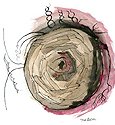
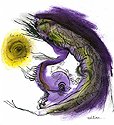
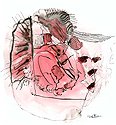
The Art of Doing NothingI have never seen automatic drawings in a form so unified and such a pleasent oneness in expression. Experiencing Joel Biroco's work guides me straight into a deep peaceful state of awareness; his automatic drawings have a hypnotic effect on me and leave me with good thoughts no matter wether I am looking at works entitled 'troubled', 'rotten' or 'the demon of pain'. His drawings seemto connect me to the concept of unity of self through harmony and balance. Joel Biroco: "An automatic drawing is the absolute antithesis of illustration, since one does not see what one is drawing until it has been drawn. It requires a practiced pen-hand and an ability to attain at will an essentially vacuous state of mind, that can be sustained for the duration of the drawing. Those who have read Austin Osman Spare will realise there is much in common between automatic drawing and sigil creation, which is why a true automatic drawing can be talismanic (Spare and Carter wrote an essay entitled Automatic drawing, and Spare's 'Book of Pleasure' expands on what he meant by 'obsessions'). Attaining vacuity seems difficult, until it is realised it is easy, again through long practice. It is the same with wuwei, it takes a long time to learn to do nothing properly. As in martial arts, it is acting from the centre." Ideomotor effect does not cover the entire process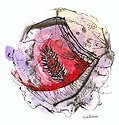

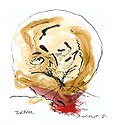
Biroco does not enjoy the term "ideomotor art"; about the term he says: "The term ideomotor effect seems to suggest that automatic drawing is a function of chance twitchings of muscles or something allthough, in a way I suppose that is the route. The term to me seems to emphasise the wrong thing. I prefer to lay emphasis on the manifestation of unconscious material rather than on the skeleto-muscular methodology, also to me the methodology is more to do with vacuity of mind than it is to do with motor responses." Automatic DrawingBiroco: "I prefer "automatic drawing" simply because of its historical connotations, and I don't really know whether "ideomotor art or Angel art" is meant to be another name for the same thing or implies subtle differences. This is the trouble with terminology. An approach like wuwei in DaoismI'm not really into "art movements" either, I find the kind of pigeon-holing that comes from this often works against creativity. I don't think art should be thought about too much, but should speak for itself. "Ideomotor" sounds a bit like art trying to have an appeal to science or psychology, trying to explain itself in some way. My background is mysticism and the occult, and "automatic drawing" of course has a ready place in the occult. To me "automatic drawing" is just a term that is okay, but any more thought than that is already too much."
|